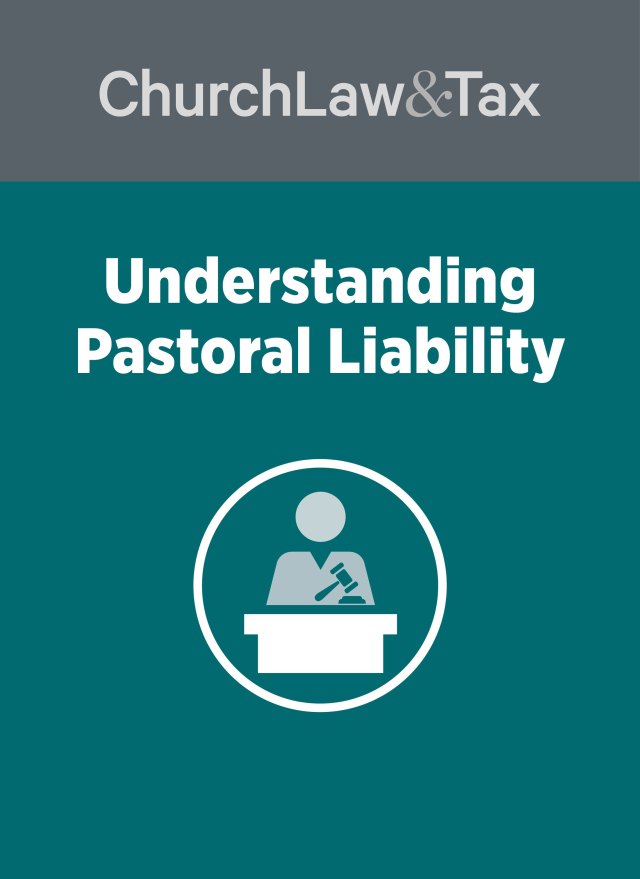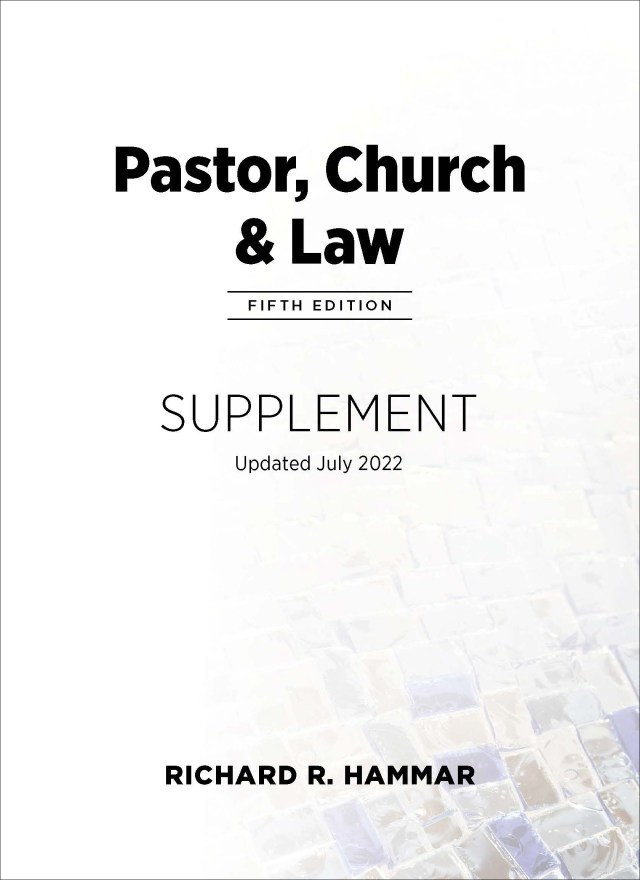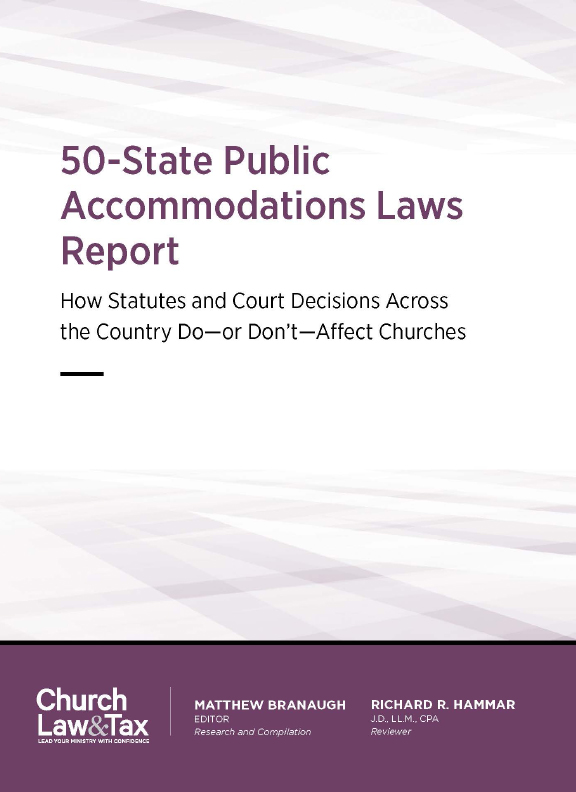Key point 10-16.07. A liability insurance policy provides a church with a legal defense to lawsuits claiming that the church is responsible for an injury, and it will pay any adverse settlement or judgment up to the limit specified in the policy. Liability insurance policies exclude a number of claims. For example, some policies exclude injuries based on criminal or intentional acts and claims for punitive damages. A church has an obligation to promptly notify its insurer of any potential claim, and to cooperate with the insurer in its investigation of claims.
A federal court in Missouri ruled that a church’s insurance company was not obligated to provide a defense or indemnification to the national offices of a church denomination in the event of a sexual misconduct claim because of an exclusion in the policy or intentional acts.
Background
An adult male (the “plaintiff”) sued his pastor, his church, and regional and national denominational offices with which the church was affiliated, claiming that his pastor groomed him for future sexual abuse beginning in late 2008 when he was 13 years old and continuing through 2010. The plaintiff alleged that the pastor groomed him by complimenting and touching him, and by hugging him “for long periods of time.”
Following the grooming, the plaintiff claimed that the pastor engaged in sexual contact with him. The plaintiff claimed that the national church “knew that harm was certain or substantially certain to result from its failure to supervise” the pastor. The national church denied all the plaintiff’s “allegations of knowledge and liability,” and denied that the pastor was its employee.
The plaintiff’s lawsuit alleged that the national church was responsible for the pastor’s acts on the basis of its “intentional failure to supervise clergy.”
The national church turned the lawsuit over to its insurance company (the “insurer”) for both a legal defense and indemnification. The insurer had issued an insurance policy to the national church with multiple coverages. The general commercial liability coverage included additional coverage for sexual acts.
This case centered on the “sexual-acts-liability coverage,” which obligated the insurer to pay
all sums which a covered person becomes legally obligated to pay as damages due to bodily injury, personal injury or emotional injury to which this coverage applies. The event or events causing the bodily injury or emotional injury must constitute a sexual act arising out of the operation of your organization; and must take place in the coverage territory during the policy period.
However, many exclusions applied to this coverage. Some exclusions applied only to the sexual-acts-liability coverage, and these appear on the sexual-acts-liability-coverage form itself, but the coverage form also incorporates various exclusions from other parts of the policy.
The court explained:
For example, the top of the sexual-acts-liability-coverage form includes a text box set off from all of the other text; in that box, a disclaimer appears, stating that the coverage “is subject to the terms of” other coverages, and the text box includes in bold and all caps “PLEASE READ THIS CAREFULLY.”
Similar language appears for a second time at the top of the list of exclusions on the sexual-acts-liability-coverage form:
Each of the exclusions set forth in the Exclusions section of the Commercial Liability Coverage Form (GL-100) and the Liability and Medical Coverage Form (BGL-11) apply to each of the Additional Coverages provided by this endorsement, unless otherwise modified herein.
One of the exclusions listed on form BGL-11 excludes “loss of any kind that is expected by, directed by, or intended by any insured or by any covered person” (italics added). The national church and the insurer referred to this as the “expected-or-intended exclusion,” and they disputed whether the exclusion applies at all to the sexual-acts-liability coverage
The insurer claimed that the insurance policy does not cover acts that are “expected, directed, or intended” by the insured. Since the only claim the plaintiff brought against the national church was an intentional tort, and insurers generally owe no duty to defend when no potential for coverage of the claim asserted against the insured exists, the insurer argued that it had no duty to defend or indemnify the national church.
The court concluded that the text of the policy “plainly and unambiguously provides that the expected-or-intended exclusion applies to the sexual-acts-liability coverage,” and so there was no coverage for the national church under the policy for the pastor’s sexual misconduct.
The court also concluded that while the insurer did not have a duty to indemnify the pastor, it had a limited duty to provide him with a legal defense.
What this means for churches
This case presents important lessons for church leaders regarding insurance coverage for sexual misconduct claims. Note the following.
1. Intentional or criminal acts
Many church insurance policies provide limited coverage for sexual misconduct, although significant conditions and exceptions often apply. In addition, church insurance policies ordinarily exclude coverage for criminal or intentional acts. The coverage of sexual misconduct claims and the exclusion of criminal or intentional misconduct creates a conflict.
The federal court in this case concluded that a church insurance policy’s exclusion of criminal and intentional acts superseded the policy’s limited coverage of sexual misconduct claims. The court reached this conclusion based on a careful reading of the insurance policy.
The takeaway point is that church leaders should not assume that their general liability insurance policy covers sexual misconduct claims, even if there is language in the policy to that effect. In this case, the court noted that the sexual misconduct coverage was subject to the general exclusion in the policy for intentional and criminal acts. The court observed:
[T]he top of the sexual-acts-liability-coverage form included a text box set off from all of the other text; in that box, a disclaimer appears, stating that the coverage “is subject to the terms of” other coverages, and the text box includes in bold and all caps “PLEASE READ THIS CAREFULLY.”
Similar language appears for a second time at the top of the list of exclusions on the sexual-acts-liability-coverage form:
Each of the exclusions set forth in the Exclusions section of the Commercial Liability Coverage Form (GL-100) and the Liability and Medical Coverage Form (BGL-11) apply to each of the Additional Coverages provided by this endorsement, unless otherwise modified herein.
Church leaders whose church is sued as a result of sexual misconduct often assume that the church’s insurance policy will provide a legal defense and pay for any judgment or settlement up to the policy limits. Such an assumption may be incorrect, since most insurance policies exclude coverage for any “intentional” or criminal acts, and some specifically exclude coverage for sexual misconduct.
As a result, some churches, like the one in this case, end up having to retain and compensate their own attorney and pay any judgment or settlement that is rendered against them. The financial impact of such unbudgeted expenses can be substantial.
2. Negligence
Note that the plaintiff in this case only sued the national church for an intentional failure to supervise clergy. In most sexual misconduct cases, plaintiffs sue churches and denominational agencies for negligence (i.e., negligent selection, negligent retention, or negligent supervision).
Such claims are not necessarily barred by an intentional misconduct exclusion in a church’s liability insurance policy, since an argument can be made that since the church is being sued for negligence, and not an intentional act, the policy’s intentional acts exclusion should not apply. After all, it was an individual perpetrator, not the church, that engaged in the intentional or criminal misconduct.
The courts have reached mixed results on the application of an insurance policy’s intentional acts exclusion to negligence claims against a church or denominational agency.
It is important for church leaders to resolve this ambiguity by retaining legal counsel to review all insurance coverages and by seeking clarification from the church’s insurance agent. The agent should be asked, “If our church is sued for negligence in a lawsuit brought by a victim of sexual misconduct, does our general liability insurance policy provide a legal defense and indemnification (up to the policy limits), or is coverage barred by the intentional acts exclusion?” Ask the insurance agent to respond to this question in writing.
3. Policy selection and renewal
Sexual misconduct claims, particularly those involving minor victims, represent one of the most common sources of church litigation.
Because of the frequency of such claims, and their potential for significant damages, it is imperative for church leaders to know if their church’s insurance policy will provide both legal defense and indemnification in the event of an adverse judgment or settlement. This should be a major consideration when shopping for insurance coverage or deciding whether to renew existing coverage. In fact, what other consideration would be more important?
4. Coverage for the perpetrator
What about the perpetrator? Does the church insurance policy provide for a legal defense? Does it provide for indemnification (payment of a settlement or judgment up to the policy limits)?
The court concluded that while the insurer did not have a duty to indemnify the pastor, it had a limited duty to provide him with a legal defense.
This conclusion, based on the language of the insurance policy, means that the perpetrator was personally responsible to pay any portion of a settlement or judgment applicable to his wrongful acts. Such a result often comes as a shock to perpetrators of sexual misconduct, and, if known, can serve as a useful deterrent to such behavior.
5. Riders
If a church’s insurance policy does not provide coverage, then ask your insurance agent if you can purchase a rider that does.
2021 U.S. Dist. LEXIS 219029, 2021 WL 5279574 (E.D. Mo. 2021)




